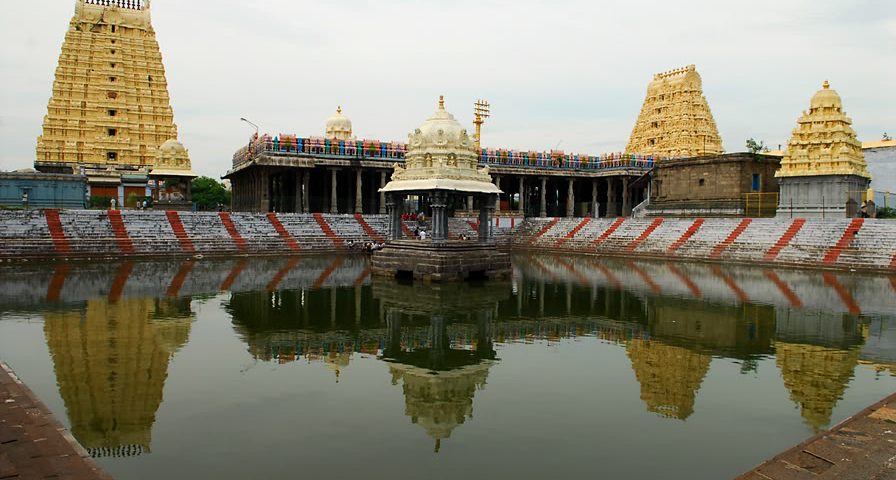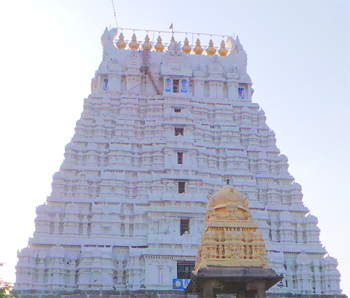Main god : Lord Shiva
Deities : Nandhi,Lingam
Location : Ekambaranathar Sannidhi St,
Periya, Kanchipuram,
Tamil Nadu 631502

Festivals :
13 day Panguni Uthiram in March-April with colourful events with processions in Silver Rath, Silver Mavadi Servai and Gold Vrushab- the Nandhi vahan of Lord Shiva is the biggest festival of the temple drawing devotee crowd in lakhs.The devotee crowd is also huge on new moon, full moon and pradosha days.
Also celebrated in the temple are Deepavali, Tamil and English New Year days with special abisheks and pujas. Thousands come to worship Lord on these days.
Workship Time :
Morning 6.00 A.m. To 12.30 P.m.
Evening 4.00 P.m. To 8.30 P.m.
Pooja Timing :
Koo Pooja – 6.00 a.m.
Ukshakala Pooja – 6.30 a.m. To 7.30 a.m
Kala santhi Pooja – 7.30 a.m. To 8.30 a.m
Uchikala Pooja – 11.30 a.m. To 12.00 Noon
Pradhosa Kaalam – 5.00 p.m. To 5.30 p.m
Sayaratchai Pooja – 6.00 p.m. To 7.00 p.m
Arthajama Pooja – 8.30 p.m.
The Temple :

This vast temple is one of the most ancient in India having been in existence since at least 600 AD. Second century AD Tamil poetry speaks of Kama kottam, and the Kumara kottam (currently the Kamakashi Amman temple and the Subramanya temple). The existing structure then, was pulled down and rebuilt by the Pallava Kings. The Cholas, who came later, also made several contributions to the temple.
No separate shrine for Parvati exists here (as in other Shiva temples in Kanchipuram).
There is a small shrine for Lord Vishnu named Thiru Nilaaththingal Thundathan. Here, the Lord Vishnu is prayed as Vamana Murthy.
The temple covers an area of over 40 acres. Reaching a height of 57 meters, the temple’s Raja gopuram (the entrance tower to the temple) is one of the tallest in South India and was built by the Vijayanagar King, Krishnadevaraya.
One notable feature of the temple is the Aayiram Kaal Mandapam, or the “hallway with a thousand pillars”, which was built by the Vijayanagar Kings. The temple’s inner walls are decorated with an array of 1,008 Siva lingams.
The sthala-virutcham is a 3,500 year old mango tree whose branches are said to yield four different types of mangoes.
Legend has it that once Parvati was doing tapas under the temple’s ancient Mango Tree. In order to test her devotion Lord Shiva sent fire on her. Goddess Parvati prayed to her brother, Lord Vishnu, for help. In order to save her, he took the Moon from Lord Shiva’s head and showed the rays which then cooled down the tree as well as Parvati.
After that, Lord Shiva again sent the river Ganga to disrupt Parvati’s tapas. Parvati devi prayed to Ganga and convinced her that both of them were sisters and so should not harm her. And so Ganga did not disturb her penance after that. Then Parvati made a Shiva Linga out of sand and got united with Lord Shiva.
According to another legend, it is believed that Parvati worshipped Shiva in the form of a Prithivi Lingam (or a Lingam improvised out of sand), under a mango tree. Legend has it that the neighboring Vegavati river overflowed and threatened to engulf the Shiva Lingam and that Parvati or Kamakshi embraced the Lingam. Shiva touched by the gesture materialized in person and married her. In this context he is referred to as Tazhuva kuzhainthaar (“He who melted in Her embrace”) in Tamil.





